Netflix may keep buffering due to misconfigurations of your router settings or ISP restrictions. Router settings may include QoS, Daisy Chain Topology, security plug-ins like Orbi Armor, and the MTU size. In some cases, Netflix keeps on buffering or gets stuck at a specific level of buffering like 25% or 5%. The issue occurs on all the Netflix content but in some rare cases, it was just limited to a particular show or movie. The problem is also not limited to a specific platform.

Due to the diversity of the platform supported by Netflix, there can be numerous reasons that may cause buffering of Netflix but the following can be easily marked as the main factors:
- Outdated or Corrupt Firmware of the Device or Router: If the firmware of the router or device (like a TV) is outdated or corrupt, then their incompatibility with Netflix may not let Netflix parse the data packets in time and thus result in the buffering problem.
- Router’s Security Plugin: If the router’s built-in security plug-in (like Orbi Armor) is interfering with the traffic between your device and Netflix servers, then the added time to check the security of the data packets from Netflix may leave Netflix in buffering.
- MTU Size of Router: You may encounter the buffering issue on Netflix if the router is sending the data packets with an MTU size that is not compatible with the Netflix servers and servers are taking extra time to parse such data packets.
- ISP Restrictions: ISPs tend to cap the web traffic from the streaming services and if your ISP is doing the same, then that may leave Netflix in buffering state.
Re-log into Netflix
A temporary glitch of Netflix may not let it properly communicate with its servers and thus cause the buffering issue at hand. Here, re-logging into Netflix may solve the problem. For illustration, we will discuss the process of logging out of the Android version of the Netflix app.
- Launch the Netflix App and tap on More.
- Now press the Sign Out button and then confirm to sign out of the Netflix app.
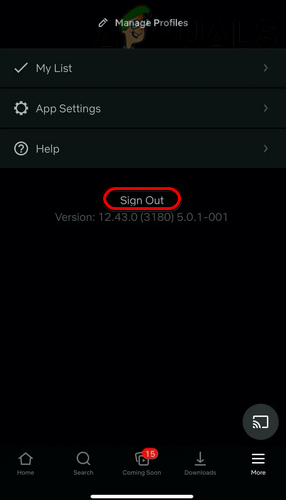
Sign Out of Netflix - Afterward, relaunch the Netflix app and re-log in to the Netflix app to check if the buffering issue is resolved.
- If not, check if connecting the streaming device (if being used) to another HDMI port (without any extension cable) of the TV resolves the issue.
- If the issue persists, check if using another Netflix profile clears out the error.
Perform a Cold Restart of the Devices and Networking Equipment
A temporary communication glitch between your device (like a TV) and the Netflix servers may result in the constant buffering of Netflix. Here, performing a cold restart of the devices and networking equipment may solve the Netflix problem.
- Power off the device (like a TV or streaming device) and networking equipment (like a Wi-Fi extender or router).
- Now unplug the power cable of these devices from the power sources.

Unplug the Router from the Power Source - Then press and hold the power button of the device (like a TV) for 20 seconds.
- Now wait for 5 minutes and plug back the power cables of the devices.
- Then power on the router and wait till it is fully powered on.
- Once done, power on the device (like a TV), and afterward, check if the Netflix buffering issue is cleared.
- If not, launch Netflix, and when it starts buffering, press/hold the power button of the device (like a TV) till the device restarts or powers off.
- Then power on the device and check if the buffering issue of Netflix is cleared.
Update the OS of the Device to the Latest Build
If the device’s OS is outdated, then its incompatibility with the Netflix servers may not let Netflix operate normally and cause the buffering issue at hand. Here, updating the device’s OS to the latest build may solve the problem. For illustration, we will discuss the process of updating the Apple TV’s firmware to the latest build.
- Launch the Apple TV Settings and open the System.
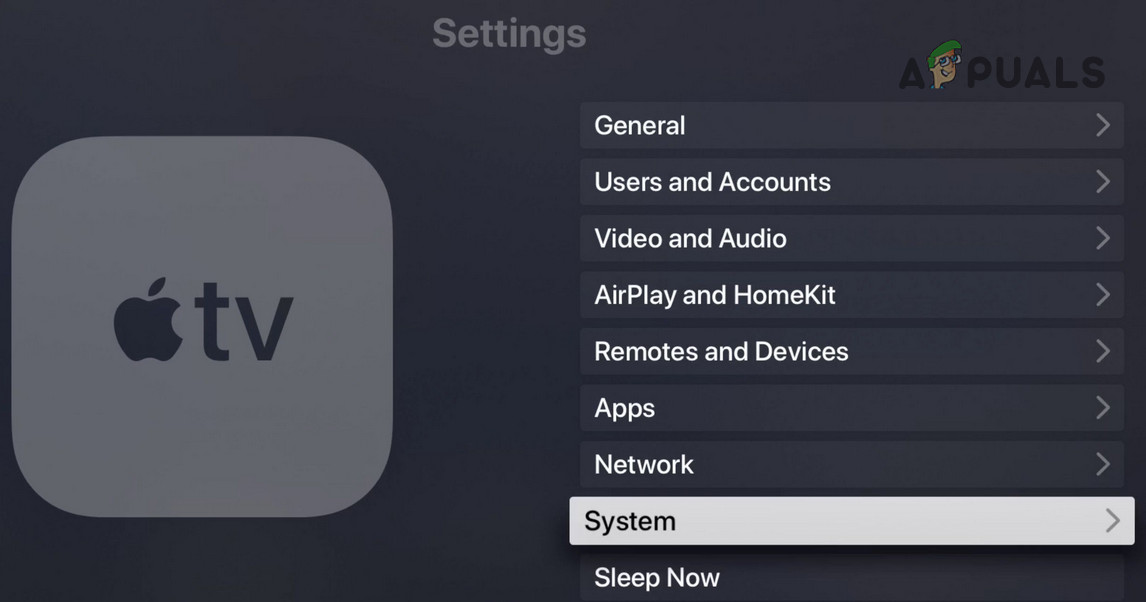
Open System in the Apple TV Settings - Now select Software Updates and click on Update Software.

Open Software Updates in the System Settings of Apple TV - Then, if a software update of the Apple TV is available, download and install it.

Update Software of the Apple TV - Once updated, restart the Apple TV and check if Netflix is operating fine.
Update the Router’s Firmware to the Latest Build
Netflix may keep on buffering if the router’s firmware is outdated as this outdated firmware may cause incompatibility with the Netflix servers and parsing of data packets from Netflix may take longer than usual. Here, updating the router’s firmware to the latest build may clear the buffering issue.
- Launch a web browser and steer to the router’s web portal (like 129.168.1.1).
- Now log in using your credentials and head to the Management (or Advanced) tab.
- Then switch to the Firmware Update tab and click on Check.

Check for the Update of the Router’s Firmware - If a firmware update is available, let it update, and once done, restart the router and other connected devices (like a TV or streaming device).
- Upon restart, launch Netflix and check if its buffering issue is cleared.
- If that fails, check if bringing the router close to the device (like a TV or streaming device) solves the problem.
- If that did not work, check if forwarding the Netflix required ports (usually, 5223, 20, 21) resolves the buffering issue.
Try Another Network or Network Type
Netflix might keep on buffering if the network hinders or caps the Netflix traffic; many ISPs cap traffic from streaming services. Here, trying another network or network type (like Ethernet) may clear the Netflix issue.
- Check if connecting the device by using the Ethernet connection (if possible) solves the problem.
- If not, disconnect the device (like a TV) from the current network and connect it to another network (like a phone’s hotspot but with a good internet speed).
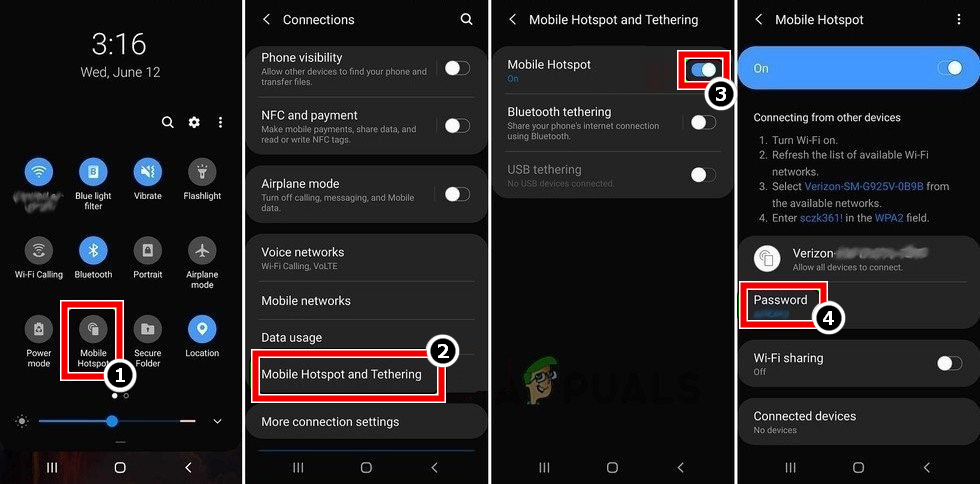
Enable Hotspot of Your Phone - Now check if the Netflix buffering issue is resolved.
- If the buffering still occurs on Netflix, disconnect all other devices from the network (like mobile phones, consoles, etc.) except the problematic device (like a TV) and restart the problematic device.
- Upon restart, check if Netflix is clear of the buffering issue.
If the issue was resolved on another network, then check if directly connecting the device to the Internet on the problematic network (bypassing the router) solves the problem. If so, then the issue is caused by the router and you may troubleshoot the router (as discussed in this article).
Disable the QuickStart Feature on the Device
Many devices (like an LG TV) have a quick start or quick boot mode (a type of standby mode) which quickly boots the device by not putting essential system modules into their default state when the TV is powered off. If a temporary glitch of the device occurs and causes the buffering issue on Netflix, then that glitch may carry on even after multiple restarts of the device. In this scenario, disabling the QuickStart or Quick Boot mode of the device may clear the Netflix issue. For elucidation, we will discuss the process of disabling the QuickStart feature on an LG TV.
- Launch the LG TV Settings and select All Settings.
- Then steer to the General tab and disable the QuickStart (or QuickStart+) feature by toggling its switch to off.

Disable QuickStart in LG TV Settings - Now power off the LG TV and unplug the TV’s power cable from its power source.
- Then wait for a minute and reconnect the TV’s power cable.
- Now, power on the LG TV and launch Netflix to check if it is clear of buffering issue.
Disable QoS of the Router
A router uses the QoS (Quality of Service) feature to prioritize the web traffic and let more important traffic pass first. If the router’s QoS feature is prioritizing other web traffic on the Netflix data packets, then that may leave Netflix in the buffering state as its data packets are not being released in time by the router. In this case, disabling the QoS feature of the router may clear the Netflix issue.
- Launch a web browser and steer to the web portal of the router.
- Then log in using your credential and head to the Advanced tab.
- Now click on QoS Setup and untick Turn Internet Access QoS On.
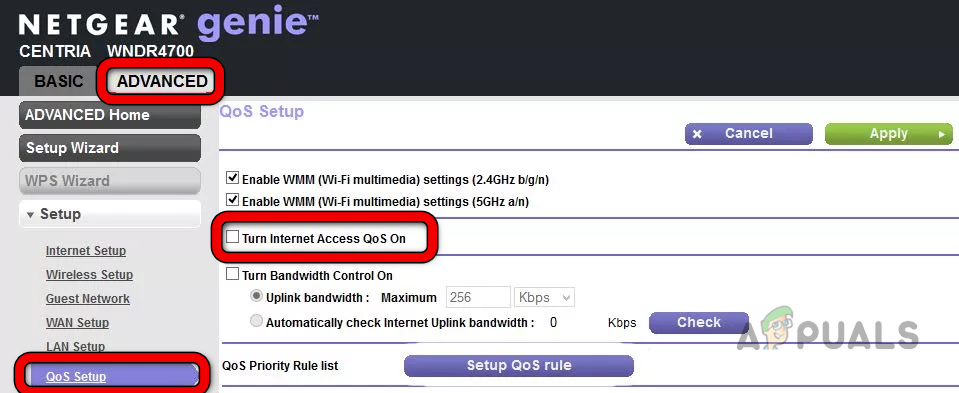
Disable QoS in the Router’s Settings - Then click on Apply and afterward, check if Netflix’s buffering problem is solved.
Disable the Daisy Chain Network Topology on the Router
The Daisy Chain network topology in a mesh network allows the network nodes to connect to the router (if the router is too far away from a node) by using another node on the network. This networking feature can sometimes break the Netflix operation as it may add some extra time in sending/receiving data packets to the Netflix servers and thus cause the buffering issue at hand. In this context, disabling the Daisy Chain network topology in the router settings may solve the problem. For elucidation, we will discuss the process of disabling Daisy Chain on an Orbi router.
- Launch a web browser and head to the web portal of the Orbi router (you may use Orbilogin).
- Now log in using your credentials and navigate to Settings.
- Then select Advanced and under Wireless Settings, untick the checkbox of the Daisy Chain and apply the changes.
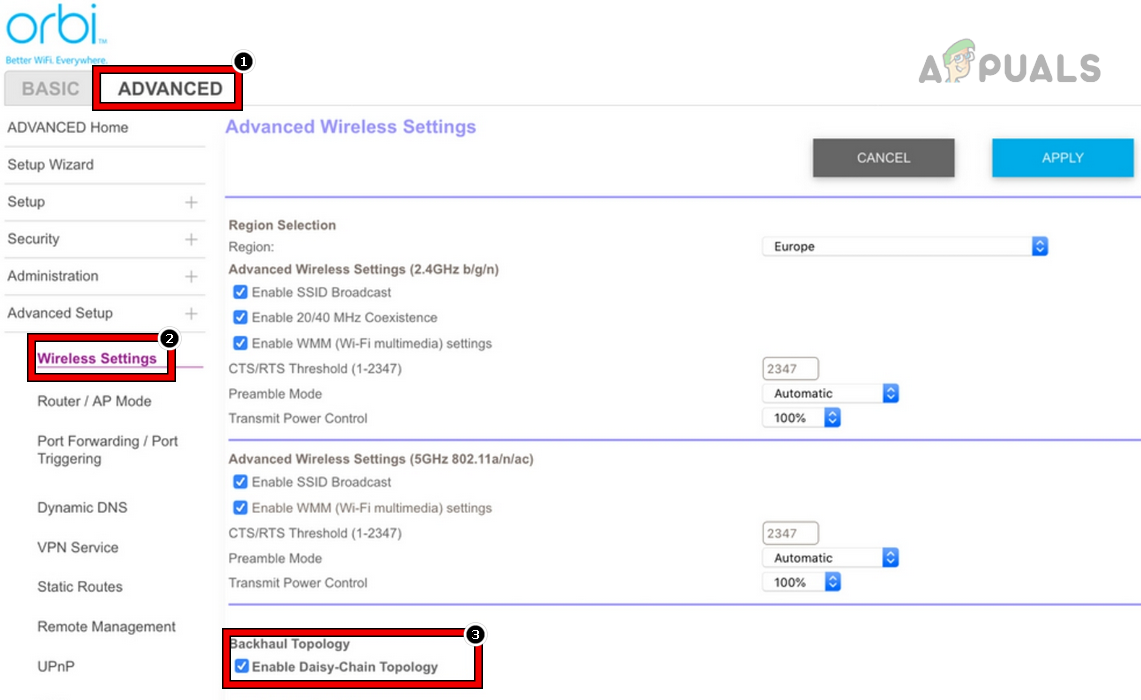
Disable Daisy Chain Topology in the Router Settings - Now restart the router, related nodes, and devices (TV, streaming device, etc.).
- Once restarted, launch Netflix and check if it is clear of the buffering issue.
Change the MTU Size in the Router Settings
MTU (Maximum Transmission Unit) size is the largest data packet that can be sent through a network and if the MTU size at which your router is transmitting is not compatible with the Netflix servers, then that may result in the buffering issue under discussion as servers may take longer than usual to parse incompatible data packets. In such a case, changing the MTU size in the router settings may clear the Netflix problem. For illustration, we will discuss the process for the Huawei ONT router.
- Launch a web browser and head to the ONT router’s web portal (like 192.168.10.1).
- Now login using the credentials (default username is admin and password is also admin) and steer to the Network tab.
- Then navigate to the sub-tab of WAN and in WAN Configuration, set the MTU Size to 1460.

Set MTU Size in the Router Settings to 1460 - Now save the changes and restart the router along with all network-related devices (like TV, streaming device, etc.).
- Once done, launch Netflix and check if its buffering issue is resolved.
Disable the Router’s Security Plugin
Many routers (like a NetGear Orbi) are equipped with built-in security like Orbi Armor. If the router’s security module hinders the web traffic from the Netflix servers, then the processing time taken by the router’s security module can add up to the buffering time of Netflix and thus cause the issue at hand. Here, disabling the router’s security module may solve the problem. For illustration, we will discuss the process for Orbi Armor (a reported culprit causing the issue).
Warning: Advance at your own risk and with extreme caution as disabling the router’s security plugin may expose devices, data, and network to threats.
- Launch the Netgear Orbi app (if not present, you may install it) and open its Settings.
- Now select Security and disable Orbi Armor (if enabled).
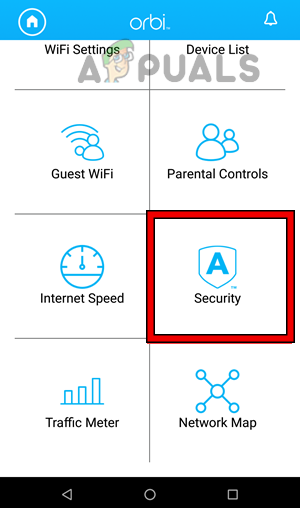
Open Security in the Orbi App Settings - Then restart the router and devices (like a TV or streaming device).

Disable Armor in the Orbi Security Settings - Upon restart, check if Netflix is buffering fine.
Reinstall the Netflix App
You may face a buffering issue on a Netflix app if the app’s installation itself is corrupt and is having compatibility issues with its servers. Here, reinstalling the Netflix app may clear the buffering issue on Netflix. For elucidation, we will go through the process of reinstalling the Android version of the Netflix app.
- Launch the Android phone Settings and select Applications or Apps.

Open Apps in the Android Phone Settings - Now open Netflix and tap on the Force Stop button.
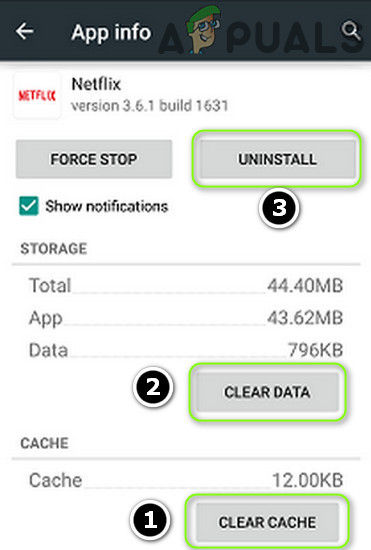
Clear Cache and Data of Netflix and Uninstall it - Then confirm to force stop the Netflix app and open Netflix’s Storage.
- Now press the Clear Cache button and then tap on the Clear Data button.
- Then confirm to clear the Netflix’s data and tap on the back button.
- Now tap on Uninstall button and then confirm to uninstall Netflix.
- Once done, restart the phone, and upon restart, reinstall Netflix, and afterward, check if the buffering issue of Netflix is cleared.
Change the Bitrate of the Stream
Not everyone has a high-speed Internet and if the Internet’s speed is not up to the mark, that may cause the buffering issue at hand. Here, changing the bitrate of the Netflix stream may solve the problem. Before proceeding, if any type of refresh rate app is being used, check if uninstalling it resolves the issue. Also, you may test the Internet speed of your connection through the Netflix app to check if it meets the Netflix requirements i.e., 3Mbps for SD, 5Mbps for Full HD, and 25Mbps for 4K Ultra HD.
- On a PC browser, head to the Netflix website, and when the buffering issue occurs, press Ctrl +Shift + Alt + S (for Windows) or Control + Shift + Options + S (for Mac) keys.
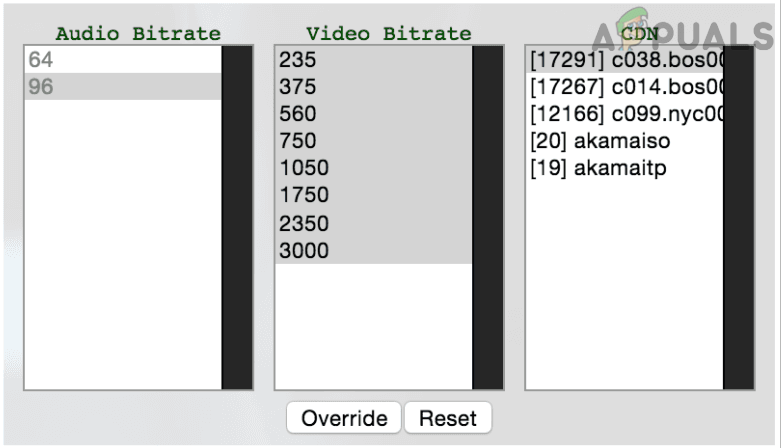
Manually Select the Bitrate for the Netflix Stream - Now manually select a bitrate (start from the lowest possible) and afterward, check if the buffering issue is resolved.
- If not or the user is not using Netflix on a PC, head to the Netflix website on a browser and click on your profile icon on the Who’s Watching screen.
- Now select Account and under Profile & Parental Controls, click on the required profile.
- Then click on Change in front of Playback Settings and under Data Usage Per Screen, select Low.
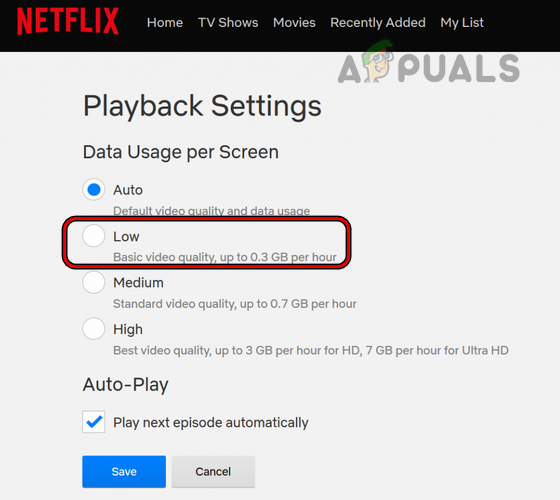
Set Data Usage Per Screen of Netflix to Low - Now click on Save and check if Netflix buffering issue is resolved.
- If so, then you may set Data Usage Per Screen to Medium (if supported by the Internet speed).
Reset the Browser Settings to the Defaults
A mere misconfiguration of a browser may cause a hindrance in the proper loading of the Netflix website and thus cause the buffering issue on the browser. Here, resetting the browser to the factory defaults may solve the problem. For elucidation, we will discuss the process of resetting the Chrome browser to its factory settings.
- Open the Chrome browser and click on the three vertical ellipses (near the top right).
- Now, in the Chrome menu, select Settings, and in the left half of the window, expand Advanced.
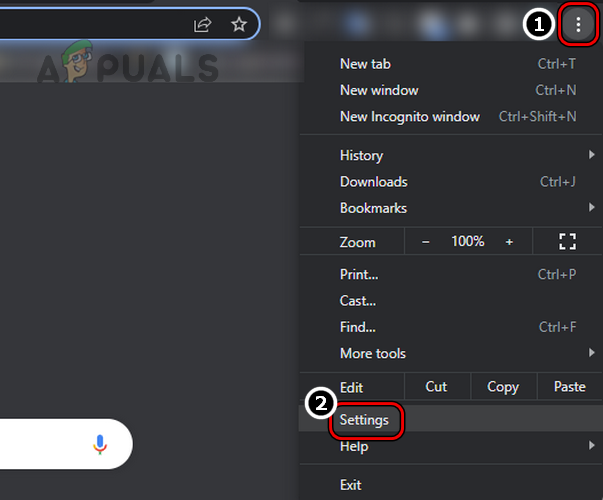
Open the Chrome Browser Settings - Then, head to Reset and Cleanup tab.
- Now, in the right half of the window, click on Reset Settings to Their Original Defaults, and afterward, confirm to reset the Chrome browser’s settings.

Reset Chrome Settings to Defaults - Once done, relaunch the browser and then head to the Netflix website to check if it is buffering fine.
- If that fails, check if the Netflix website loads fine in another browser or you may try the Netflix PC app (e.g., from Microsoft Store).
Reset the Router to the Factory Defaults
If the router’s firmware is corrupt, then its inability to properly handle the web traffic between your device and Netflix servers might cause the buffering issue. Here, resetting the router to the factory defaults may solve the Netflix problem. Before proceeding, make sure to keep the info under the hand that is required to set up the router after resetting it.
- Locate the router’s reset button, generally, on the bottom or back of the router.
- Now use a paperclip (or any other pointy object) to press and hold the router’s reset button.

Reset Your Router - Then wait for 30 seconds or till the router restarts, then release the reset button.
- Upon restart, re-set up the router as per the ISP requirements, and once done, check if Netflix’s buffering problem is cleared.
If the issue persists, check if using another router (from a friend or family) resolves the problem.
Reset the Device to the Factory Defaults
If the firmware of the device (like a TV or streaming device) is corrupt, then it might have become incompatible with the Netflix streaming modules and caused the buffering issue at hand. Here, resetting the device to the factory defaults may solve the Netflix problem. For illustration, we will go through the process of resetting an Apple TV to the factory defaults.
- Open the Apple TV Settings and open the System.
- Then open Reset and click on Reset or Reset and Update (if the TV’s firmware is also to be updated).

Open Reset in the Apple TV Settings - Wait till the TV resets to its defaults (it can take some time) and once done, set up the Apple TV as a new one.

Reset the Apple TV to the Factory Defaults - Afterward, reinstall the Netflix app and check if it is operating
If none of the above worked and the issue was resolved on another network, then you may contact ISP support to resolve the issue. If not, then you may contact Netflix support or device support (like Apple support) to clear out the error.